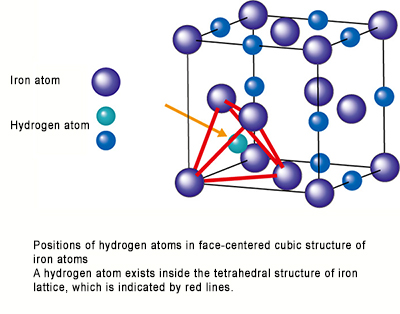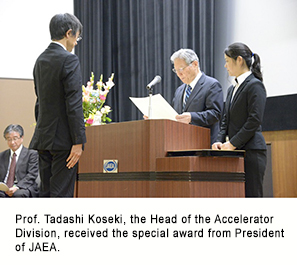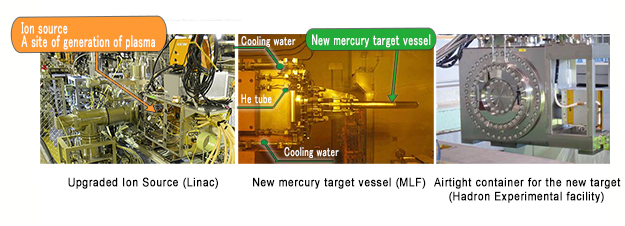| Ā° J-PARC News - October 2014 (Issue #114) |
| Ā° Outcomes & Achievements |
|---|
| |
| ĀúNeutron Diffraction Used to Determine the Position and Amount of Hydrogen in Iron Under High Temperature and Pressure! |
|---|
| Under high temperature and pressure, hydrogen in iron is present not only inside octahedral sites, which was indicated by established theory, but also inside tetrahedral sites of cube metal lattice. This fact was elucidated using the PLANET, High Pressure Neutron Diffractometer, of the Materials and Life Science Experimental Facility (MLF). This discovery is expected to advance research on iron and hydrogen, such as improving the quality and strength of iron and steel materials, and clarifying the conditions inside the earth's iron core. |
| These results were achieved through joint research by the Quantum Beam Science Center and the J-PARC Center of Japan Atomic Energy Agency (JAEA), the Institute for Materials Research of Tohoku University, and other institutions, and were published online in the English science journal Nature Communications on September 26.http://www.nature.com/ncomms/2014/140926/ncomms6063/full/ncomms6063.html |
  
 * Click here to enlarge. * Click here to enlarge. |
  
 * Click here to enlarge. * Click here to enlarge. |
| |
| ĀúJ-PARC received "The First Prize for Research and Development" at Fiscal 2014 JAEA President's Awards |
|---|
| The J-PARC Accelerator Division received a "The First Prize for Research and Development" for its success in 400 MeV acceleration of a proton beam at the linac. This award recognizes J-PARC's development of an acceleration cavity with annular-ring coupled structure (ACS), the first achievement in the world with a proton accelerator, and success in achieving acceleration at the linac's design beam intensity of 400 MeV through measures such as installing a 972 MHz klystron high-frequency power supply for driving the acceleration cavity. These results were essential toward achievement of the designed beam intensity for all three accelerators of J-PARC, and it is expected that J-PARC facilities will make even greater contributions to progress in academic research and science/technology. At the awards ceremony on October 6, Prof. Tadashi Koseki, the Head of Accelerator Division, represented the division in receiving a certificate of commendation from Dr. Shojiro Matsuura, President of the JAEA. Four groups and persons involved with J-PARC also received other awards. |
 
 * Click here to enlarge. * Click here to enlarge. |
| |
| Ā£to Page Top |
| |
|
| (1) At the linac, beam current was increased during adjustment operation from the previous 30 mA to 50 mA, and transport into the 3 GeV synchrotron was successfully achieved. (2) At the MLF, the mercury target vessel was replaced with a new vessel incorporating improvements to the beam window and other features. (3) At the Hadron Experimental Facility, permission of the Nuclear Regulation Authority to change the radiation generator equipment was received in early September. Target replacement was carried out from mid-September to mid October. |

 * Click here to enlarge. * Click here to enlarge. |
| |
| Ā£to Page Top |
| |
|
| ĀúFiscal 2014 J-PARC Safety Audit (October 21) |
|---|
| As part of efforts to strengthen J-PARC's safety management system, it was decided to begin, in this fiscal year, carrying out safety audits by external experts of our safety management and emergency response system. On the day of the audit, auditors with expertise in areas such as safety/human engineering and radiation science/engineering carried out an interview survey of the center director, deputy director, leader of the safety section, persons in charge of radiation handling, and other relevant staff. In addition, on-site conditions were observed at each J-PARC facility, and interviews were conducted with facility managers and persons in charge of radiation generators. At the end, the auditors provided overall comments and suggestions. |

 * Click here to enlarge. * Click here to enlarge. |
| |
| Ā£to Page Top |
| |
|
| ĀúOzora Marche at the Muramatsu-san Kokuzodo Temple (October 12, Tokai Village) |
|---|
| This event was held by the Tokai Sightseeing Guide for carrying down the culture and history of Tokai Village to the next generation, J-PARC jointly participated in the event with Ibaraki Atomic Energy Council for the first time and set up a "Science Experiment Corner". J-PARC staff froze flower, rubber balls and other items with liquid nitrogen (approx. -200℃), and then visitors had experience the unusual low temperature world by crushing and breaking them into pieces against the ground. Also an experiment where a superconductor was cooled and run along a rail made of magnets and observation of natural radiation with a cloud chamber were conducted. Many people participated, ranging in age from children to adults, and the event was a great success. |
| Āú21st International Collaboration on Advanced Neutron Source ICANS-XXI (September 29 to October 3, Mito City) |
|---|
| This event was held at the Ibaraki Prefectural Culture Center, and attended by about 220 researchers from major research institutions and facilities involved with nuclear spallation neutron sources in eight countries. There were 210 presentations in 11 workshops for each area of research, and a "Blue Sky Session" for brainstorming where participants in the hall joined the discussion. Throughout the entire event, there were lively questions and answers. Approximately 90 people participated in the J-PARC tour on the final day. They were divided according to the equipment they wished to see, and the groups examined/took a closer look at each experimental equipment in detail. |
| ĀúThe 10th NOBUGS 2014 (September 24-26, Kobayashi Hall, KEK Tsukuba Campus) |
|---|
| NOBUGS (New Opportunities for Better User Group Software) is a workshop for exchanging information and opinions among software developers (researchers, IT engineers) at large research facilities using synchrotron radiation, neutrons and muons. This year, the event was organized by J-PARC Center, with the High Energy Accelerator Research Organization (KEK) and Comprehensive Research Organization for Science and Society (CROSS) as co-sponsors, and held as a satellite workshop of ICANS-XXI held from September 29 to October 3. There were 68 registered participants (32 from Japan and 36 from overseas), 27 oral presentations including 4 invited speakers, and 29 poster presentations. The participants reported on the software development situation in a variety of large facilities both inside and outside Japan. A Most Outstanding Poster Award (Dr. Yano, Ibaraki University) and an Outstanding Poster Award (Dr. Hanashima et al., CROSS) were selected by vote of the participants. |
| ĀúInternational Symposium on Present Status and Future Perspective for Reducing Radioactive Wastes (October 9-10, Tokyo) |
|---|
| The problem of spent fuel due to the use of nuclear power is a global issue, and to resolve the problem, efforts are being made in Japan, Europe, the US and countries to reduce radioactive wastes. Recently, the Japan Atomic Energy Agency (JAEA) held the above symposium for the general public, with participation from research institutions, universities, corporations and other groups from Japan and other countries. Reports were given on the current situation of efforts to address this issue, future perspectives, and other topics. |
| Regarding J-PARC, Dr. Hiroyuki Oigawa of the JAEA's Office of Strategic Planning (also of the Nuclear Science and Engineering Center (NSEC) and J-PARC Center) gave a talk entitled "Reducing Radioactive Waste with Accelerators" in which he provided an overview of accelerator-driven systems (ADS) and other topics. Dr. Kazufumi Tsujimoto of the NSEC's Research Group for Nuclear Transmutation System (and J-PARC's Transmutation Section) gave a talk entitled "Transmutation Technology using Accelerator-Driven Systems (ADS) " in which he reported on recent study topics in the ADS field, and details of the transmutation experimental facility being planned as part of the J-PARC project. |
| ĀúFourth Special Lecture Meeting of the Foundation for High Energy Accelerator Science (October 10, Tokyo) |
|---|
| Every year in October, the Foundation for High Energy Accelerator Science (FAS) holds a lecture meeting attended by accelerator science experts being active in a variety of research fields. This year, J-PARC Center Director Dr. Yujiro Ikeda presented an overview of facilities, including how J-PARC's Materials and Life Science Experimental Facility (MLF) is being used by industry. Also, a speaker from Ibaraki Prefecture, which has two neutron beamlines, covered topics such as industrial utilization of neutrons and research results. |
|
©2014 J-PARC Center. All rights reserved.
|
|